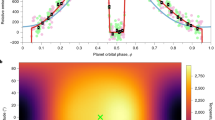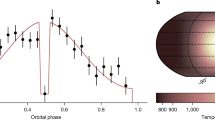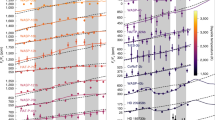Abstract
Short-period gas giants (hot Jupiters) on circular orbits are expected to be tidally locked into synchronous rotation, with permanent daysides that face their host stars and permanent nightsides that face the darkness of space1. Thermal flux from the nightside of several hot Jupiters has been detected, meaning energy is transported from day to night in some fashion. However, it is not clear exactly what the physical information from these detections reveals about the atmospheric dynamics of hot Jupiters. Here we show that the nightside effective temperatures of a sample of 12 hot Jupiters are clustered around 1,100 K, with a slight upward trend as a function of stellar irradiation. The clustering is not predicted by cloud-free atmospheric circulation models2,3,4. This result can be explained if most hot Jupiters have nightside clouds that are optically thick to outgoing longwave radiation and hence radiate at the cloud-top temperature, and progressively disperse for planets receiving greater incident flux. Phase-curve observations at a greater range of wavelengths are crucial to determining the extent of cloud coverage, as well as the cloud composition on hot Jupiter nightsides5,6.
This is a preview of subscription content, access via your institution
Access options
Access Nature and 54 other Nature Portfolio journals
Get Nature+, our best-value online-access subscription
$29.99 / 30 days
cancel any time
Subscribe to this journal
Receive 12 digital issues and online access to articles
$119.00 per year
only $9.92 per issue
Buy this article
- Purchase on Springer Link
- Instant access to full article PDF
Prices may be subject to local taxes which are calculated during checkout



Similar content being viewed by others
Data availability
The data that support the plots within this paper and other findings of this study are available from the corresponding author upon reasonable request.
Code availability
The Gaussian process regression code used is publicly available and can be found at https://github.com/ekpass/gp-teff. The Spitzer Phase Curve Analysis pipeline is publicly available and can be found at https://github.com/lisadang27/SPCA.
References
Showman, A. P. & Guillot, T. Atmospheric circulation and tides of ‘51 Pegasus b-like’ planets. Astron. Astrophys. 385, 166–180 (2002).
Komacek, T. D., Showman, A. P. & Tan, X. Atmospheric circulation of hot Jupiters: dayside–nightside temperature differences. II. Comparison with observations. Astrophys. J. 835, 198 (2017).
Komacek, T. D. & Tan, X. Effects of dissociation/recombination on the day–night temperature contrasts of ultra-hot Jupiters. Res. Notes Am. Astron. Soc. 2, 36 (2018).
Zhang, X. & Showman, A. P. Effects of bulk composition on the atmospheric dynamics on close-in exoplanets. Astrophys. J. 836, 73 (2017).
Morley, C. V. et al. Forward and inverse modeling of the emission and transmission spectrum of GJ 436b: investigating metal enrichment, tidal heating, and clouds. Astron. J. 153, 86 (2017).
Tinetti, G. et al. A chemical survey of exoplanets with ariel. Exp. Astron. 46, 135–209 (2018).
Dang, L. et al. Detection of a westward hotspot offset in the atmosphere of hot gas giant CoRoT-2b. Nat. Astron. 2, 220–227 (2018).
Wong, I. et al. 3.6 and 4.5 μm Spitzer phase curves of the highly irradiated hot Jupiters WASP-19b and HAT-P-7b. Astrophys. J. 823, 122 (2016).
Zhang, M. et al. Phase curves of WASP-33b and HD 149026b and a new correlation between phase curve offset and irradiation temperature. Astron. J. 155, 83 (2018).
Knutson, H. A. et al. 3.6 and 4.5 μm phase curves and evidence for non-equilibrium chemistry in the atmosphere of extrasolar planet HD 189733b. Astrophys. J. 754, 22 (2012).
Zellem, R. T. et al. The 4.5 μm full-orbit phase curve of the hot Jupiter HD 209458b. Astrophys. J. 790, 53 (2014).
Cowan, N. B. et al. Thermal phase variations of WASP-12b: defying predictions. Astrophys. J. 747, 82 (2012).
Wong, I. et al. 3.6 and 4.5 μm phase curves of the highly irradiated eccentric hot Jupiter WASP-14b. Astrophys. J. 811, 122 (2015).
Maxted, P. F. L. et al. Spitzer 3.6 and 4.5 μm full-orbit light curves of WASP-18. Mon. Not. R. Astron. Soc. 428, 2645–2660 (2013).
Stevenson, K. B. et al. Thermal structure of an exoplanet atmosphere from phase-resolved emission spectroscopy. Science 346, 838–841 (2014).
Stevenson, K. B. et al. Spitzer phase curve constraints for WASP-43b at 3.6 and 4.5 μm. Astron. J. 153, 68 (2017).
Louden, T. & Kreidberg, L. SPIDERMAN: an open-source code to model phase curves and secondary eclipses. Mon. Not. R. Astron. Soc. 477, 2613–2627 (2018).
Mendonça, J. M., Malik, M., Demory, B.-O. & Heng, K. Revisiting the phase curves of WASP-43b: confronting re-analyzed Spitzer data with cloudy atmospheres. Astron. J. 155, 150 (2018).
Kreidberg, L. et al. Global climate and atmospheric composition of the ultra-hot Jupiter WASP-103b from HST and Spitzer phase curve observations. Astron. J. 156, 17 (2018).
Beatty, T. G. et al. Spitzer phase curves of KELT-1b and the signatures of nightside clouds in thermal phase observations. Preprint at https://arxiv.org/abs/1808.09575 (2018).
Komacek, T. D. & Showman, A. P. Atmospheric circulation of hot Jupiters: dayside–nightside temperature differences. Astrophys. J. 821, 16 (2016).
Bell, T. J. & Cowan, N. B. Increased heat transport in ultra-hot Jupiter atmospheres through H2 dissociation and recombination. Astrophys. J. 857, L20 (2018).
Cowan, N. B. & Agol, E. A model for thermal phase variations of circular and eccentric exoplanets. Astrophys. J. 726, 82 (2011).
Yadav, R. K. & Thorngren, D. P. Estimating the magnetic field strength in hot Jupiters. Astrophys. J. 849, L12 (2017).
Parmentier, V., Fortney, J. J., Showman, A. P., Morley, C. & Marley, M. S. Transitions in the cloud composition of hot Jupiters. Astrophys. J. 828, 22 (2016).
Powell, D., Zhang, X., Gao, P. & Parmentier, V. Formation of silicate and titanium clouds on hot Jupiters. Astrophys. J. 860, 18 (2018).
Roman, M. & Rauscher, E. Modeled temperature-dependent clouds with radiative feedback in hot Jupiter atmospheres. Astrophys. J. 872, 1 (2019).
Kataria, T. et al. The atmospheric circulation of the hot Jupiter WASP-43b: comparing three-dimensional models to spectrophotometric data. Astrophys. J. 801, 86 (2015).
Arcangeli, J. et al. Climate of an ultra hot Jupiter. spectroscopic phase curve of WASP-18b with HST/WFC3. Astron. Astrophys. 625, A136 (2019).
Bean, J. L. et al. The transiting exoplanet community early release science program for JWST. Publ. Astron. Soc. Pac. 130, 114402 (2018).
Cowan, N. B. & Agol, E. The statistics of albedo and heat recirculation on hot exoplanets. Astrophys. J. 729, 54 (2011).
Schwartz, J. C. & Cowan, N. B. Balancing the energy budget of short-period giant planets: evidence for reflective clouds and optical absorbers. Mon. Not. R. Astron. Soc. 449, 4192–4203 (2015).
Schwartz, J. C., Kashner, Z., Jovmir, D. & Cowan, N. B. Phase offsets and the energy budgets of hot Jupiters. Astrophys. J. 850, 154 (2017).
Ingalls, J. G. et al. Repeatability and accuracy of exoplanet eclipse depths measured with post-cryogenic Spitzer. Astrophys. J. 152, 44 (2016).
Cowan, N. B. & Agol, E. Inverting phase functions to map exoplanets. Astrophys. J. 678, L129 (2008).
Lewis, N. K. et al. Atmospheric circulation of eccentric hot Neptune GJ436b. Astrophys. J. 720, 344–356 (2010).
Cowan, N. B., Fuentes, P. A. & Haggard, H. M. Light curves of stars and exoplanets: estimating inclination, obliquity and albedo. Mon. Not. R. Astron. Soc. 434, 2465–2479 (2013).
Cowan, N. B., Chayes, V., Bouffard, É., Meynig, M. & Haggard, H. M. Odd harmonics in exoplanet photometry: weather or artifact? Mon. Not. R. Astron. Soc. 467, 747–757 (2017).
Majeau, C., Agol, E. & Cowan, N. B. A two-dimensional infrared map of the extrasolar planet HD 189733b. Astrophys. J. 747, L20 (2012).
de Wit, J., Gillon, M., Demory, B.-O. & Seager, S. Towards consistent mapping of distant worlds: secondary-eclipse scanning of the exoplanet HD 189733b. Astron. Astrophys. 548, A128 (2012).
Rauscher, E., Suri, V. & Cowan, N. B. A more informative map: inverting thermal orbital phase and eclipse light curves of exoplanets. Astron. J. 156, 235 (2018).
Allard, F., Hauschildt, P. H. & Schweitzer, A. Spherically symmetric model atmospheres for low-mass pre-main-sequence stars with effective temperatures between 2000 and 6800 K. Astrophys. J. 539, 366–371 (2000).
Knutson, H. A. et al. A map of the day–night contrast of the extrasolar planet HD 189733b. Nature 447, 183–186 (2007).
Knutson, H. A. et al. Multiwavelength constraints on the day–night circulation patterns of HD 189733b. Astrophys. J. 690, 822–836 (2009).
Demory, B.-O. et al. A map of the large day–night temperature gradient of a super-Earth exoplanet. Nature 532, 207–209 (2016).
Angelo, I. & Hu, R. A case for an atmosphere on super-Earth 55 Cancri e. Astron. J. 154, 232 (2017).
Keating, D. & Cowan, N. B. Revisiting the energy budget of WASP-43b: enhanced day–night heat transport. Astrophys. J. 849, L5 (2017).
Russell, H. N. On the light variations of asteroids and satellites. Astrophys. J. 24, 1–18 (1906).
Bell, T. et al. Mass loss from the exoplanet WASP-12b inferred from Spitzer phase curves. Preprint at https://arxiv.org/abs/1906.04742 (2019).
Acknowledgements
The authors thank T. Bell for providing the updated energy balance model code, T. Komacek for providing his analytic day–night temperature difference code and L. Kreidberg for an early look at her WASP-103b phase-curve paper. Thanks to J. Mendonça for providing the phase-curve parameters from his WASP-43b paper. Thanks to E. Pass for an early look at her Gaussian process temperature estimate results. Thanks to J. Bean and V. Parmentier for helpful discussion and comments about the manuscript.
Author information
Authors and Affiliations
Contributions
D.K. led the data analysis and wrote the manuscript. N.B.C. discussed ideas and contributed to writing the manuscript. L.D. provided the Spitzer data analysis pipeline and helped with reducing Spitzer phase curves.
Corresponding author
Ethics declarations
Competing interests
The authors declare no competing interests.
Additional information
Peer review information: Nature Astronomy thanks Thaddeus Komacek and the other, anonymous, reviewer(s) for their contribution to the peer review of this work.
Publisher’s note: Springer Nature remains neutral with regard to jurisdictional claims in published maps and institutional affiliations.
Supplementary information
Supplementary Information
Supplementary Figs. 1–8 and Tables 1–3.
Rights and permissions
About this article
Cite this article
Keating, D., Cowan, N.B. & Dang, L. Uniformly hot nightside temperatures on short-period gas giants. Nat Astron 3, 1092–1098 (2019). https://doi.org/10.1038/s41550-019-0859-z
Received:
Accepted:
Published:
Issue Date:
DOI: https://doi.org/10.1038/s41550-019-0859-z
This article is cited by
-
Revealing the atmospheres of highly irradiated exoplanets: from ultra-hot Jupiters to rocky worlds
Astrophysics and Space Science (2023)
-
A reflective, metal-rich atmosphere for GJ 1214b from its JWST phase curve
Nature (2023)
-
Diurnal variations in the stratosphere of the ultrahot giant exoplanet WASP-121b
Nature Astronomy (2022)
-
A survey of exoplanet phase curves with Ariel
Experimental Astronomy (2022)
-
A unique hot Jupiter spectral sequence with evidence for compositional diversity
Nature Astronomy (2021)



